Accordions and Theremins and Music Writers!
Sasha Frere-Jones and Maura Johnston and pals read at Le Poisson Rouge even while Bitch Magnet plays in the back room, well before the fabulous Gilles Peterson spins late tonight. (I love him so.) ALSO! Enjoy the theremin of Pamelia Kurstin at Barbes and the accordion compositions of Guy Klucevsek at Roulette.
Herman Cain And Tina Brown: Where Are They Now?
Herman Cain And Tina Brown: Where Are They Now?
by Matt Haber
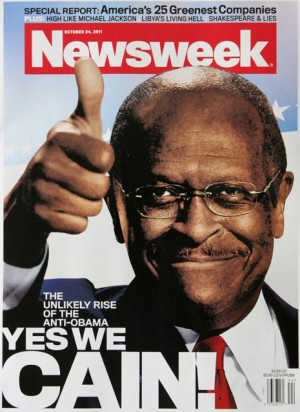
Some drunk Irishman once said “There are no second acts in American lives,” which is true, but not if you’re English. Then you get more acts than the last Lord of the Rings movie. Tina Brown edited Tatler, then Vanity Fair, then The New Yorker, then Talk, then something called Newsweek.
Here are some of the things you’d learn reading the October 24, 2011 issue of Newsweek: Paul McCartney, 69, is “a famous British hunk” and newly married to Nancy Shevell; Occupy Wall Street, a movement led by “the young and angry,” is “not exactly the Arab Spring”; Madeleine Albright “like[s] to knit”; Robert Bork thinks Joe Biden isn’t “a very thoughtful or intelligent man”; Designer Haider Ackerman is the “The ‘It’ Boy of Paris”; Lars Ulrich’s favorite mistake was telling Quentin Tarantino he couldn’t use “Enter Sandman” in Kill Bill. Let’s compare then with today!
THEN…
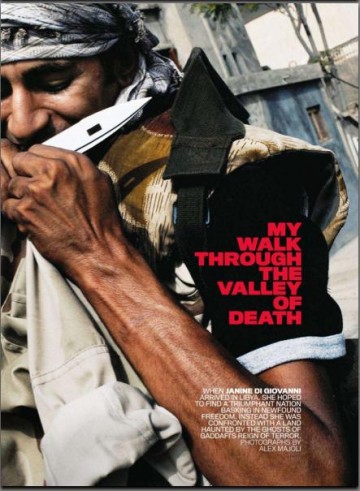
“In Benghazi and Tripoli, I meet a lot of young people like Huda Abuzeid: Libyans who had been forced to leave, were educated to high standards abroad, and are now back to build a new country… But nation building, especially in a place that was ruled by fear for so long, is ‘not going to be easy,’ admits Mazin Ramadan, director and senior adviser to Ali Tahouni, the new finance and oil minister. Ramadan settled in Seattle in 1984 to be part of the high-tech boom and came rushing back when the revolution started. ‘Libyans don’t imagine an Iraq-type scenario here,’ he says. ‘They imagine it will be like Europe, France, the U.K. I have even heard they want it to be like Switzerland.’” — My Walk Through the Valley of Death, by Janine di Giovanni.
NOW…

THEN…
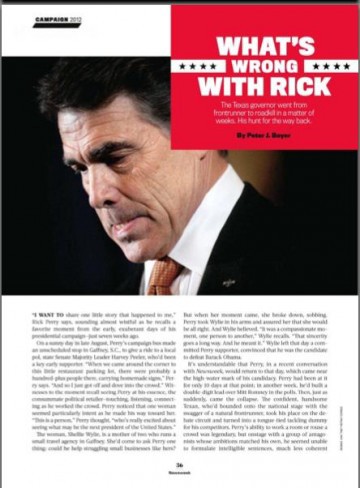
“What’s Wrong With Rick: The Texas governor went from frontrunner to roadkill in a matter of weeks. His hunt for the way back.” — Peter J. Boyer
NOW…
Peter Boyer leaves Newsweek for Fox News.
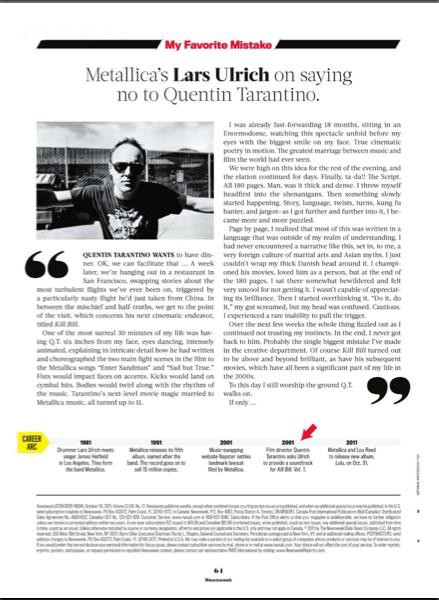
THEN…
“When Newsweek ran its first Green Rankings two years ago, climate change was high on the agenda. The U.S. House had passed a cap-and-trade bill to put a price on carbon, the world’s biggest economies were about to make history with an agreement to cut greenhouse-gas emissions… Since then, green momentum has seriously stalled, at least in the public sector… If governments are hesitating, the globe’s big companies missed the memo. Top-ranked companies are approaching green projects with increasing tenacity, even in this weak economy.” — The World’s Green Giants, by Ian Yarett
NOW…
“We are announcing this morning an important development at Newsweek and The Daily Beast. Newsweek will transition to an all-digital format in early 2013. As part of this transition, the last print edition in the United States will be our Dec. 31 issue.” — A Turn of the Page for Newsweek, by Tina Brown.
THE TAKEAWAY
It’s really hard to maintain a print newsweekly.
Related: Bin Laden or Jared Leto: Whose Career Was Hotter In 2000?
Matt Haber has actually never read Newsweek until this week, but he hopes to find a stack on the street someday in 2021, if there still are streets then.
New York City, October 23, 2012

★★★ A subtle light show, undermining a simple forecast. A blue morning grayed up quickly, as expected. The air under the clouds was damp and mild, unexpectedly relaxing after days of brittle brightness. Before noon, the first raindrops fell, but the second raindrops ignored the cue. Instead the stratus layer thinned, showing high white patches above. Shadows on the windowshades sharpened, then gradually blurred, then sharpened again. In late afternoon, there was a rumor of golden sun glimmering somewhere, indirectly, off beyond other buildings. Directly outside was still gray, and thicker gray uptown. But off toward the harbor, the sky was scaled with silver. Over Broadway in the 60s, things wrapped up with a smooth evening fade from gray to dark blue.
Unfortunate Woman Has No Choice But To Blog
“Until I have other options I have to keep doing this.”
— Attend the tragic tale of the Netroots bloggers.
Ask Polly: Is He Crazy, Or Am I?
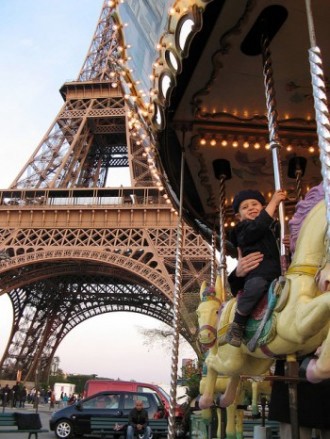
Appearing here Wednesdays, Turning The Screw provides existential crisis counseling for the faint of heart. “Chicken tenders for that empty place where your soul should go!”
Dear Polly,
First of all, you must excuse my English, I’m actually French. Plus, I don’t have autocorrect for English on this thing so I’m kind of forced to go with the flow. Anyway!
I know you already kind of wrote about that stuff but I’m still wondering if you’ll help motivating me: I’m completely — and I mean it, completely — stuck on a guy.
We met each other in high school, kind of fell in love, kind of nothing happened because we were probably too young and shy and whatever. Time flew by, we lost contact — I thought for good — and I remember telling one of my college friends that this guy (whatever I could remember of him from that time anyway) could pretty much have been THE guy. I don’t actually believe in THE one love but I mean it in the way of “he could have been MY choice.” Anyway, he did not turn out being anyone’s choice and life did go on, as it usually (and thank god for that) does.
But we did meet again last year, after 10 years, and both reacted the same way: like complete dumbasses. We hung out a couple of times, nothing happened (he actually lives in south France and I live in Paris, so the timing and place did pretty much suck).
At last, not bearing it longer, I took initiative and told him (texted him really) frankly that I’d just like more. This confession was followed by lots of mutual “I’ve always wanted to…” “I wish we had spoken this out earlier…” etc. etc. So everything seemed good and we were just about to meet again, on purpose and with a plan and then it backfired. It backfired completely and in my face!
He came to me and said something like, “Well, I’ve thought about it, and yeah, we’re like…we’re different.” (Me thinking: No shit? You mean I’m no 5 feet tall man?! And really saying something that vaguely sounded like “Mmm. Yes, I see.”)
And from that moment on we both avoided contact.
Until he texts me again, after months, saying he’s coming to Paris. Of course, I answer. Then, he doesn’t answer back. And finally when I’m about to give up, he answers (remember, HE contacted me in the first place): “Yeah, I’m gone again, I thought it would be a bad idea to see each other, too difficult, you know why.” Am I actually supposed to know that?
So I stay there, cell in my hand, flaggerbasted (not sure I’m spelling it right), in a nice “WTF”-style. So to sum it up, my questions are:
1. Are you actually sure, and I mean a 100% sure, that our common belief in THE one is that stupid?
2. Do you think I’m crazy for thinking he’s crazy?
3. Do you think, as I’m afraid of saying so to myself, that I should actually, definitely, clearly and totally give that guy up?
How can it be that when you like someone for so long, they may not like you back? Love is organized wrong!
Unorganized Beatrice
p.s. I’m really sorry, my English sounds like a bad mix-up of bad bad bad American TV series 🙁
Dear Unorganized Beatrice,
First, I just want to thank you for one of the most absurd sentences I’ve ever read in any advice-seeking letter, anywhere: “He actually lives in south France and I live in Paris, so the timing and place did pretty much suck.” Mmm, yes. What a tale of woe! You in Paris, he in the south of France, and far too different from each other to tolerate the monumental hassles of hopping on one of those clean, delightful trains whizzing hither and thither across the gorgeous green countryside! Yes, too vastly different, utterly too different, to be traveling and making ze hot French love chaque weekend!
Clearly, this man is a fuckwit. Scared or ambivalent, wussified or paralyzed, just not that bold or just not that into you. Who can tell, Beatrice? Quel dommage! And aren’t you French persons the ones to blame for the phrase “Vive la difference!”, which translates roughly as “Long live the motherfucking difference between bold, disorganized women in Paris, and scared but still oddly alluring pussies in the South of France!”?
I am also flaggerbasted (which I think translates roughly as “generously basted in confusion and bewilderment and, um, national pride”) over this guy’s behavior. How do you have the long conversation of “If only…” and “I wish we had…” and then not leap onto the nearest train filled with delightful French folks speaking to their small dogs and eating their baguettes, and then leap off in Paris to do whatever it was you wished you’d done decades prior? I mean, what the fuck? You can’t spend a few empty hours with your delightful French man-purse in your lap, sipping your red wine and pointing your beautiful, pointy French-man nose (God, I love a pointy French-man nose) out the window at the verdant countryside, in order to land in the heart of Paris, where Beatrice awaits, heart pounding in anticipation? Qu’est-ce que your major malfunction, buddy?
It just goes to show that people don’t appreciate what they have, whether they’re in the South of France nibbling on fromage delicieux, or right here in the States, gumming a stale Cheeto. How many times in your life are you truly attracted to a man, attracted enough to ignore his cluelessness and his stank and sleep with him? Supposedly men go through this several times an hour, but women? Maybe once a year? So when women are attracted, they want to make that shit happen. “Get ‘er done!” that’s our motto when lightning strikes. I still remember calling this guy I had a crush on in high school, in order to get ‘er done one summer when we were home from college. He talked a big game about how much he dug me, but in person, he was spooked by my forward nature (or he thought I was fucking gross, who knows?). And now he’s married and he’s some kind of a missionary (which I believe means he always has to use the missionary position). Who’s sorry now, motherfucker?
But I digress. No, I don’t think believing in true love is stupid, but I tend not to refer to it as The One because that mostly tends to get you hung up on flaccid little dipshits from high school. Just because you’re worked up into that “Get ‘er done” state doesn’t mean you should start attributing magical qualities to the guy even before you so much as hold his stupid hand. (I’m not blaming you for that, of course — I’m just saying that believing in The One can be pretty fraught. Plus it’s far healthier to keep your mind open to The Many.) Your guy seemed to want all of those magical imaginings to happen, too, but then he couldn’t follow through. Doesn’t that say it all, really?
Because love is organized in lots of different ways, actually, depending on who’s doing the organizing. Deeply disorganized, pathologically hesitant men can be intriguing, sure, but it sounds like you might be more suited for someone who shows up at your door and speaks using actual words and doesn’t disappear when confronted with tough questions and doesn’t fear la difference.
But Beatrice, do you get less interested when a man is interested? Are you hung up on ambivalent men from the past for a very good reason, because you tend to undervalue those who actually seem taken with you in the here and now? I’d suggest opening your mind to men who don’t seem very romantic at the moment, but who might just seem romantic once you get to know them a little better and realize that they’re much more complex and charismatic than they at first appear. One of the crazy things that happens as you get older is you start to pay less attention to how someone seems (mysterious, provocative, sexy) and you pay more attention to how someone actually is (talkative, responsible, smart). I’m not talking about looks, to be clear. I’m talking about intrigue, which is absurdly overrated. Mysterious men, as they age, often transform before your eyes into insecure, self-obsessed control freaks. Regular old dorks, though, become more and more lovable and sexy. Personally, I favor the dork who doesn’t realize how very sexy he is — but these are mostly hunted to extinction.
At any rate, the world is filled with les hommes delicieux, is it not? Or at the very least Paris is. Stop mooning over this refrigerator monkey and find yourself someone who isn’t afraid of trains, and girls, and differences.
xoxoxox,
Polly
Dear Polly,
Can you tell us a little bit about your qualifications for this job as the Awl’s new existential crisis counselor? Because I think I could probably counsel people, too. Maybe they should hire me instead of you.
Ben
Dear Ben,
I’m sorry, you lost me at “job.” And what is this word “hire”? Is that a verb of some kind? Does it mean “approve of” or “condone”? Or does it mean “endure” or “loosely tolerate,” something like that?
Are you picturing me in a plush office with a view of the Manhattan skyline, sipping gourmet coffee with Choire, whose pants fit perfectly, and Chris Lehmann, whose pants are ill-fitting? Does Choire talk too much in meetings while Alex rolls his eyes? Does Carrie look like the assassin girlfriend on “Archer”? Does John order in tapas? What am I wearing? I’m hot, right? Really hot or just a little hot? Do I have a husky voice?
And people respect me and stuff? They listen to me when I open my mouth and talk using words? Mmm. Maybe I manage a few people? Bright young men who spend their lunch hours at the gym, right? And I’m a little bit arrogant and demeaning to them? I point out which muscle groups need more work? I make them run to the beauty store to pick up my overpriced skin lotions, and then I insult their prose, and I draw dirty cartoons and leave them on their desks, and I make other bad choices that give my poor, hunky underlings post-traumatic stress nightmares?
Do the bathrooms have stalls, or are they more private than that? Are there good magazines in there? Do we order in really excellent Indian food every Wednesday? Do we get a bonus every time our columns get more than 30,000 page views? Is there an annual Awl employee retreat, in northern Italy? With really good chianti and quality narcotics and high-priced Italian hookers?
Do literary types flock to the Awl offices, to praise us and to take us out to lunch and to edit our novels, for free? Does my office have a door on it? Is there provocative art on the walls? Is their really good cocaine in the top drawer of my giant polished oak desk?
How much do I make? Can I afford to summer on Fire Island or just somewhere in the buggy hinterlands of Maine? No, no — maybe I summer with wholesome New England intellectuals, like in a Wallace Stegner novel? And sometimes I skip work and drive down to Maryland, just to eat oysters and clams and stuff out of a big silver bucket while getting fall-down drunk on cold pilsner? But I look hot even when I’m slurring my words and stuffing my face with shellfish, right?
Do I eventually leave my perfectly good husband for one of my hunky underlings, causing a sordid office scandal? Does my hunky underling turn out to be kind of a boring person with whom to share an impeccably decorated brownstone? Does my husband get full custody of the kids? Do the kids start to hate me because they’ve noticed that I care more about my fabulous literary friends and my quality narcotics and my Indian take-out and my Italian leather boots than I care about them? Do I laugh loudly and engage in witty banter around the clock, but secretly live a desperately lonely existence? Do I almost die one night, in a pool of my own vomit? Do people eventually stop listening when I talk, and then I get fired and I have to sell everything, even those great boots, and I’m living in a shelter? And does a reporter end up doing a New Yorker profile on my fast rise and fall in the go-go, topsy-turvy world of underfunded web start-ups? And then everyone in the civilized world reads it, and they laugh so hard that coffee shoots out of their noses?
Because that sounds awesome.
Look, Ben. I have no doubt that you’re much better qualified to fill my very lucrative position of Senior Vice President of Existential Affairs. But let me refer you to rule number one in the existential crisis playbook: 1. Life is no-fair.
Keep those dreams alive anyway, you!
Polly
Feeling flaggerbasted? Write to Polly immediately!
Previously: Ask Polly: Should I Quit My Job To Be An Artist?
Heather Havrilesky (aka Polly Esther) is our new existential advice columnist. She’s also a regular contributor to The New York Times Magazine, and is the author of the memoir Disaster Preparedness (Riverhead 2011). She blogs here about scratchy pants, personality disorders, and aged cheeses. Photo by Anthony J.
Menstruating Women Almost As Good As Men At Multitasking
Men are better than women at multitasking. This report does not say why, but I suspect it has something to do with the fact that we have a lot of practice at not giving our full attention to things that do not interest us.
The Woolworth Building Has a Nice Lobby and the Terrorists Are Still Winning

Last night I was at a party at The Wooly, which is a bar on the ground floor of the Woolworth Building. It was a fun party, though I basically just talked to the two people that I knew there. The bartenders made delicious drinks that went particularly well with the decor of the place. There was a painting hanging above the bar of a lady in olde-time garb sipping a cocktail in front of a peacock that I could not stop staring at.
The most memorable part of the night, though, happened before I got to the party, when I arrived at the Woolworth Building not knowing where to find the bar.
I had never been in the Woolworth Building’s lobby, though I’d seen pictures of it and had heard it was so beautiful. I should have gone in to see it before 9/11 happened, because they closed it to the public after that. But last night, as I came to the entrance and saw the “No Tourists Allowed Beyond This Point” sign that had always previously kept me out, I thought to myself, “Hey, today I am not a tourist! I have been invited to this building and have a legitimate question to ask the guard sitting inside.”
So I walked in through the doors and looked up at the glimmering, gold and blue and green mosaic of the Gothic cathedral ceiling (how high above me 100 feet? 200?!) and all around at the football-field sized arrangement of chambers — what Columbia University historic preservation professor Andrew Dolkart calls “one of the most lavish spaces in New York.”
Heineicke and Bowen, a very prominent decorating firm in the early twentieth century, was hired to do most of the work inside, and they prepared barrel-vaulted mosaics filled with flowers and birds and other ornament that were modeled after the early Christian mosaics in Ravenna, Italy. They were responsible for the stained-glass dome over the marble staircase that led to the Irving Bank. And it was they who put together the marble, the bronze, the plaster, the mosaics, and the stained glass — all of the different materials used to create this very special interior.
I walked as slowly as I could towards the desk, taking it all in. It was 7:30 p.m. There was no one else there.
“Can I help you?” said the guard when I got up to him.
“Hi,” I said. “I’m looking for the Wooly Bar. Can you tell me where that is?”
“Sure,” he said, perfectly friendly. At the risk of seeming rude, I went back to gazing up and around in awe. “You’re gonna go back outside and turn right, and then make a right at the corner. And walk a little bit until you see a big black window. The door’s right there.”
“Thanks,” I said and gave him a smile. “Man, it’s fantastic in here.”
“Mmm hmm,” he said, like he was very used to people telling him that.
I thought to say, “It must be nice to get to sit here and look at such a beautiful place all the time.” But then I thought that maybe the niceness of that might have worn off for him a long time ago. He seemed a little tired, like he might be nearing the end of his shift.
So instead I said, “Can I walk around and look at it some more before I go?”
“Nope,” he said.
So I left, a bit sad.
Maybe if I buy one of the 40 luxury condominiums that Alchemy Properties are turning the building’s top 30 floors into, I will be able to come back and look around some more. A 2,500-foot apartment will only be 7.5 million dollars.
Statue Made For Dead Bear
“Berlin’s famed Knut was officially immortalized on Wednesday with a bronze statue in the city’s zoo. Though the cuddly polar bear won’t be forgotten anytime soon, the memorial keeps the dream alive for future generations.”
"The Scream" at MoMA in the Cold Digital Age
by Elizabeth Lopatto
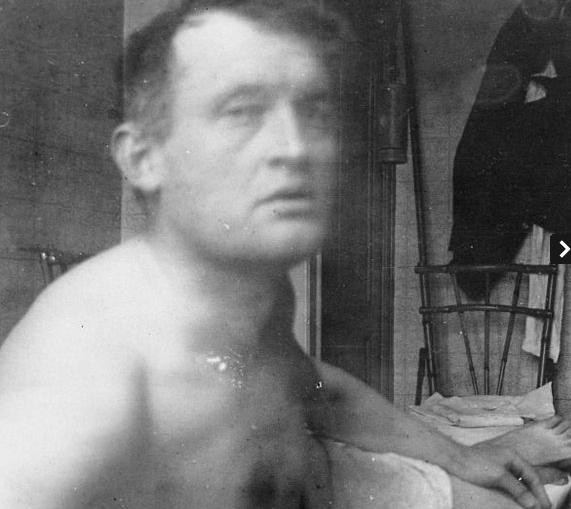
There has been a lot of wrong-headed criticism of the internet by people who ought to know better. Which is to say, by writers. I am immediately suspicious when a writer doesn’t acknowledge the obvious similarities between words on a page and the words and images on a screen. Writing itself is an isolating technology, just an older one, and reading silently, to yourself, is an isolating practice, and a relatively new one.
These technophobic screeds surface a few times a year; they’ve tailed off some, although I suppose there will always be authors masochistic enough to make their own dunce caps and parade around in them, in exchange for money or attention. I am tired of rewarding bad behavior with my attention; my attention is a limited resource. I refuse to be outraged by arguments that haven’t substantively progressed since before I hit puberty.
That these pieces continue to appear in roughly the same form, though, tells me something else: There’s a real anxiety felt by a lot of people that’s fueling them. I find the current state of affairs frustrating: because we keep seeing the same pieces over and over, we aren’t talking accurately about what’s making us anxious. Mostly, we’re just reiterating that we are anxious.
What is sobering about the internet is not that it’s isolating per se — I find it attractive precisely because it’s got people on it — but that it feels less satisfying than in-person interactions. This much the critics have right. What they don’t have right is why.
The internet has to privilege two senses, sight and hearing, over the others. These senses are represented because they’re the easiest to reproduce, not because they’re the most important.
I’m uneasy with the internet because I’m embodied. Neither looking at a person nor listening to him is as immediate or intimate as touching him. The iPad’s existence acknowledges this in its sterile way, but we can all agree, I think, textureless glass is not as much fun as — off the top of my head — wood grain, loosely woven linen, grass, bare skin.
There’s a kind of deranged Cartesianism at play in internet culture, where we’re encouraged to view ourselves as brains, or at least eyeballs, being carted around by slabs of meat. The implicit view is that the “I” is located in the brain. Our uneasiness stems from something pretty obvious: the “I” isn’t in the brain; it’s in the brain as it exists in the meat. The body and the brain are inseparable, and the body’s needs are crucial for the brain. The internet, as wonderful as it often is, isn’t satisfying to us as full animals.
Full-calorie interactions usually involve touch: a hug hello, a friendly handshake. There’s smell, too, especially in the summer when everyone’s sweaty. Sometimes also taste; I doubt it’s a coincidence that many social events involve dinner or drinks. The world of difference between a video chat with a friend and dinner with her has nothing to do with isolation and everything to do with embodiment. You can’t hug her, you can’t split an entree, you can’t spill your drink on her.
The arm-waving, chain-clanking spectre of embodiment hovers around the arguments regarding e-readers and actual books. There is absolutely nothing wrong with taking pleasure in the smell of a book, or the texture of a page between your fingers. We will never be without books. What strikes me as likelier is that books will become art objects, like the illuminated manuscripts of the Middle Ages. Probably more writers will explore the form of the written page.
Some writers do this already. There’s Mark Danielewski, who invites readers to flip books upside-down, and who uses the printed form of his words to alternately emphasize or undermine the action in the words. Or Julio Cortazar, whose choose-your-own adventure Hopscotch takes advantage of the form of the codex to invite readers to skip around. Or Jonathan Safran Foer, who created Tree of Codes from another book by literally cutting out pieces.
The thing is, though, the pleasure of the page’s texture doesn’t invalidate the pleasure of being able to read Vanity Fair without wrecking my wrists and shoulders hauling it around, to say nothing of not having to pay for a book which is now in the public domain. Nor do I mean to denigrate the joy of hauling around a huge library in my purse, especially when I’m traveling. If enjoying a book is based just on the words on a background, who cares what form it’s in?
The smartest writing I’ve seen on the subject deals directly with how the form affects the reader; Lev Grossman described the difference between e-readers and books as being, essentially, the difference between the codex, which is how most on-dead-tree books are printed, and the scroll, which is mimicked by the e-reader. The Bible, he said, became popular as it became a codex readers could flip through to consult, rather than a scroll that made individual passages hard to locate. This kind of observation of how kinetics matter for content strikes me as the best approach to considering online life.
People make distinctions between the online world and the real-life world, although our behavior is recognizably that of the same person in both. The difference has to do with the limited nature of the internet interaction. I can no longer destroy music through too much love, by playing it too many times, making the tape break, creating scratches on the CD or record. I can’t accidentally dog-ear an online photo, or drop it in the bath and watch the colors run — and that photo’s colors aren’t dependent on what kind of monitor I’m using. Typing in all caps and screaming demand different things from my body. Screaming requires way more emotional engagement. It requires breath — expanding my diaphragm, throwing my chest out to get enough air in my lungs — and a willingness to shred my vocal chords to be heard. Typing in all caps requires hitting “caps lock.”
I find it profoundly soothing to live with art. I like having it in my home as an object that ages and degrades with me, that reflects where it sat in the sun too long in its faded colors, or has a slight crease in the corner from where the matting slipped, or where the paint has started to flake. We’re living creatures, after all, and we’ve got to attend to our animal needs.
Watching a sunset isn’t just about looking at the way the light plays in the clouds, though that’s nice enough. It’s not just the wind that comes up, or that the air smells cooler. It’s how everything around is bathed in the light, how the whole world seems to pause.
* * *
The Scream is the most-stolen painting in the world. Today, it — a version of it — goes on view at MoMA.
Reproductions of The Scream don’t really work. I’m not going to reheat Walter Benjamin on reproduction here; I don’t really find the idea of a talisman-magic attached to an original convincing1. Just strictly speaking, there’s the practical issue of being able to reproduce organic wear and tear. Paintings are like a favorite t-shirt, worn to perfection after years, with weird stains from sweat and wine, worn patches at the hem from rubbing against your jeans, places where the fabric pilled because you habitually carry a tote bag on the left side of your body.
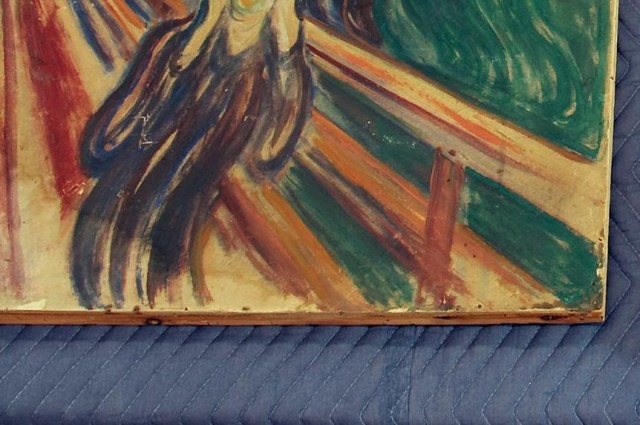
When I saw it, I was in Norway for midsummer, staying with my friend Adam. We’d worked together in New York for a now-defunct science magazine. He lived near the Munch Museum in the multicultural neighborhood Tøyen. Nearby was Karl Johans gate, which begins at Oslo’s Sentralstasjon, which is a lot like Penn Station but smaller and cleaner. The street, which ends at the Royal Palace, is repeatedly featured in Edvard Munch’s work. We spent my first day in Oslo, a Sunday, walking around the neighborhood. The sidewalks are embossed with Ibsen quotations in stainless steel. These words mark Ibsen’s daily walking route. I have no idea what they said.
Present-day Oslo has approximately the population of the city proper of Portland, Oregon, but over a slightly larger area: 586,000 people over about 175 square miles. It is eminently walkable; in some places, the sidewalks are wider than the streets.
We spent my second day at the Munch Museum. I suggested we go out of proximity rather than interest. I’d seen reproductions of The Scream; who hasn’t?
In 2008, MoMA and the Van Gogh Museum mounted its big Van Gogh blockbuster in New York, and I dragged myself through a seething mass of people — the kind of crowd that seems more insect than mammal — to see it. I was underwhelmed. Starry Night, the painting that launched a thousand dorm room posters, looked just like always. There was nothing new or moving. I vastly preferred Starry Night Over the Rhone because the brushwork was more obvious; it was more apparent a human had made it.
There’s some kind of halo we want to get from seeing an original, and that’s what the MoMA had banked on in its Van Gogh exhibit. So I went to the Munch Museum to say I’d seen The Scream, just like I could say I’d seen Starry Night or the Mona Lisa — not to have a reaction to it.
It was arranged in a threesome with two other similar works, Despair and Anxiety. At first glance, from a distance, The Scream was nothing special — just the thing I’d seen hundreds of times before. Then I stepped closer and the damn thing changed.
I could see the cardboard it was painted on. I could see scratch marks in the paint. The viscera of the painting hadn’t been captured by the reproductions. I closed my eyes and the gaping, mummy-like “O” of the mouth immediately flashed onto my eyelids.
The afterimage practically reeked of sulphur.
* * *
There are, actually, two painted versions of The Scream. The Oslo National Gallery has the earliest, signed and dated 1893. The Munch Museum’s is neither signed nor dated. They attribute it to “1910?” officially, though many believe it is from much earlier. (Both dates are in fact in question: the signed 1893 version is signed twice, and only dated at the time of the second signature.)
The “1910?” version was one of the paintings bequeathed to Oslo on Munch’s death, and Munch’s records were willfully obtuse. In the Munch Museum version, the wavy brushstroke used by the artist adds to the uncertainty and claustrophobia already present in the composition. The gaps in the paint expose the cardboard, the crudeness born of urgency.
In addition, the Munch Museum has a pastel version, and still another exists privately.2 This last, from 1895, is the one that has come to MoMA. This is a version that has never been stolen. It is now owned by an anonymous person, who may or may not be Leon Black, who spent $119.9 million for it at Sothebys this spring.
I bought a copy of Sue Prideaux’s Behind the Scream, which turned out to be a masterfully researched biography. A sickly child, Munch was born in 1863; Munch’s mother and closest sister died before he turned 20. His father, a doctor and pietist fanatic, provided the seeds for a king-hell rebellion. Munch lost his virginity to hat enthusiast Milly Thaulow, who was married to someone else at the time. Other members of what became his set included Swedish playwright and painter August Strindberg, a romantic rival for the charms of sometimes-model Dagny Juel, who eventually married Polish writer Stanisław Przybyszewski before being murdered by another lover in Tbilisi in the view of her 5-year-old son.
Munch later sent a remarkably half-assed marriage proposal to lover and muse Tulla Larsen after she lent him a great deal of money and then chased him all over Europe. Here it is, in all its glory:
“In my misery I think you would at least be happier if we were married. It would be a kind of home for you to bear my name — everything else would be as before — I would have the absolute right to freedom in every aspect of my life.”
They ended things for good after Munch was accidentally shot in his left hand in her presence; it’s not clear whether she actually shot him, though he blamed her for the injury. He took the shooting especially badly: it was his working hand that was injured, but also Munch — who was the kind of hot that made people lose IQ points in his presence, well into his forties, and like all attractive men, vain to an unholy degree3 — resented her for “ruining” his beauty. He hid the maimed hand for the rest of his life. Larsen got custody of all their friends in the breakup.
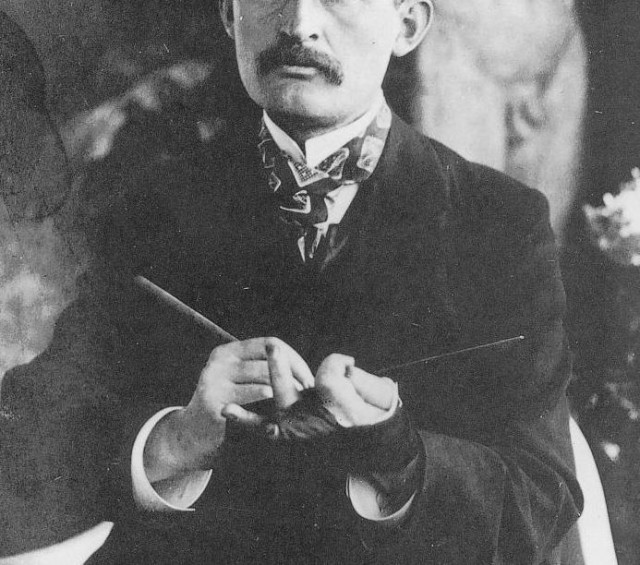
Munch spent the majority of his life broke, drunk, and hungry, although he would eventually find supporters in Germany, allowing him to provide the care of his frequently institutionalized schizophrenic sister and the aunt who raised him. This didn’t happen until Munch dried out in Copenhagen in 1908, following an episode of alcohol-induced dementia.
During his later years, his art was denounced as degenerate by Hitler. He slept with many, possibly most, of his female models right up until his death of pneumonia in 1944 while Norway was occupied by Nazis. He left his unsold paintings to the city of Oslo, which opened the Munch Museum for his works in 1963.
Prideaux’s great care with Munch’s intellectual history and philosophy help explain something of his appeal — besides, of course, his obvious beauty.
Not that I’ve got anything against beauty.
* * *
On the longest day of the year, I watched the sunset from the roof of Oslo’s opera house. The creeping nightfall continued past midnight, pink clouds scattered across the blue sky like flamingoes in a lake. A dim version of the blue hour persisted all night, until the sun started making preparations to rise around 4 a.m. The night was exceedingly blue; I could still see without the aid of the streetlights, which had nonetheless turned themselves on.
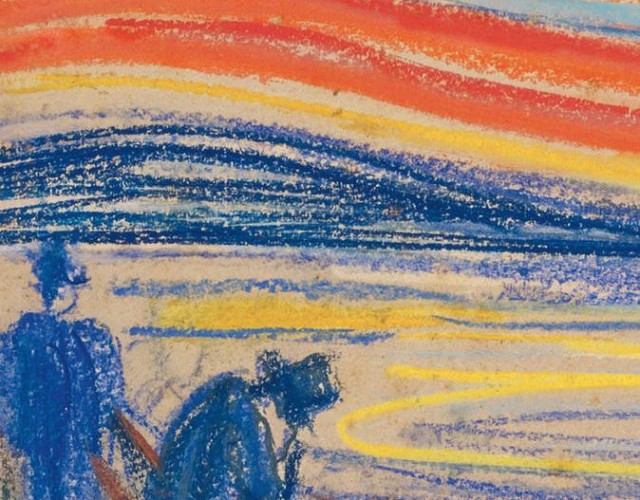
Adam and I were in the neighborhood anyway because we’d tried to go to an art show called Bring Your Own Beamers, “beamers” here meaning projectors, not cars. There was a large, white structure composed of what appeared to be canvas, PVC and shipping containers that had been set up behind the opera house, in and on which artists would project their works. The idea behind the show was that the organizers would provide the structure and power sources and the artists could show up with their own projectors with their art — a one-night free-for-all show.
This was all fine, except that when we arrived at the show, only a handful of people brought projectors. My favorite of these few, brave souls was a woman, dressed entirely in white, who had seated herself against a wall where the Euro Cup’s current match, the Czech Republic vs. Portugal, was projected. The match was effectively played on the woman as well. A few people had stopped to watch.
I realized as we stood around, hoping more people would set up projectors, that the odds were stacked against any would-be artists anyway. They would be forced to compete with the pornographically beautiful sunset. Nature has no sense of taste or propriety and isn’t afraid of overkill, and so we gave up on the art thing and walked up the front of the opera house. The opera house’s roof slopes down toward the fjord on the outer edges and up toward the sky in the middle. We walked all the way to the top and stood there, staring at the sunset. I was blissfully untroubled by thought.
Oslo is 59.9 degrees north, which is why the midsummer days are so long. It was hard to tell while I was there how much temporal confusion was due to the jet lag and how much was simply the excessive light. I slept with a mask on my face to block out the sun, but my sleep cycle was still shorter than usual and my mood was buoyant to the point of spasticity. I fairly levitated. I was reminded of how thoroughly the environment affects animals; I was reminded that I am an animal.
Munch’s “soul painting” was an explicit response to the mannered paintings being subsumed by photography. Munch used the brush to do things impossible with a camera. Later, in his sobriety, he would use his camera to capture things impossible with a brush: portraits of himself walking through his paintings — he called them his children, so those shots were effectively family portraits — as a ghostly blur, or in one shot of a double-exposure but not the other.
Munch kept as many of his paintings as possible, abusing them in the process. He called this the “horse cure,” according to Prideaux. He amused himself by throwing his paintings into the trees or using them as lids when he was cooking, dragging them with nails or allowing them to be rained on. He considered paintings bought by the National Gallery and subsequently varnished to be ruined.
Munch adopted his horse cure from friend-turned-rival Strindberg. He was interested in the role of chance in art; whether something would last forever, or even just a generation after the death of the artist, was arbitrary. The horse cure was part of that, and he didn’t worry about destroyed paintings because, per Prideaux, “a brilliant thought never dies.”
The Scream of course features a man, reduced nearly to a skull, with skin tinted nausea-green, clutching his hands to his ears and screaming, with a hellish sunset behind him. Munch wrote, in his diary, in 1892, “I went along the road with two friends — “:
The sun set.
Suddenly the sky became blood — and I felt the breath of sadness.
A tearing pain beneath my heart
I stopped — leaned against the fence — deathly tired
Clouds over the fjord of blood dripped reeking blood.
My friends went on but I just stood trembling with an open wound in my breast trembling with anxiety. I heard a huge extraordinary scream pass through me.
The Scream is a sunset that doesn’t pass at a glance into kitsch; a rarity. The inferno isn’t immediately obvious as a sunset. It’s apocalyptic in tone, the long strokes of red slapped across the sky. It is probably the most successful expression of Munch’s philosophy of painting. “Just as Leonardo da Vinci studied human anatomy and dissected corpses, so I was trying to dissect souls,” he wrote.
The horse cure and emotional rendering of the sunset are of a piece with all of Munch’s work: art as an organic object. Munch was reluctant to part with his “children,” Prideaux writes, but when he did, he told his collectors to let them out to see the sun from time to time, for their health. His art existed as part of the world, not simply as a representation of it, but as something that would degrade and change over time, as do we all.
Munch’s paintings live carefully indoors these days, in a museum, with curators who will restore them when they are fragile, as the Munch Museum did in 2006, after The Scream was stolen and held captive for two years. Most recently restored was his work Puberty; I’d never seen or heard of it before. The painting is of a nude girl, hands folded in her lap. Her expression is puzzled, ashamed. Behind her, her bedsheets are spotted with blood — her first period. Puberty in fact hadn’t been on display for 10 years while curators fixed it up; this summer was its grand re-entry into the museums.
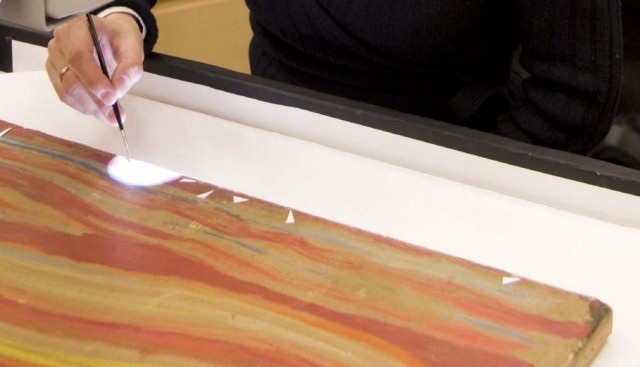
As people age, we have to be more careful with their bodies; the same is true of paintings. The curators had in no way destroyed the texture of the painting; it was still roughly textured and had not — at least apparently, to an amateur eye — been varnished.
In the sketch for Puberty, displayed on the wall immediately before entering the room with the painting, the girl sits with a shadow falling to her right, the viewer’s left. In the painting, the shadow falls to her left, the viewer’s right. Adam told me that I found this more satisfying — and I did — because as a Western viewer, my eyes were trained to travel from left to right. Munch had realized that the shadow could not precede the girl.
The problem with the projection free-for-all that we saw a few days later wasn’t just that the exhibit was too sparsely attended and under-produced, though that didn’t help. It was that after seeing Munch’s work, which is sensual in both form and content, most of the projections felt sterile, inhuman, uninteresting. The blue shipping containers draped in white cloth featured projections of — for instance — green gears on a black background, shifting. Some footage of what appeared to be an interpretive dance piece with text-speak lingo about “getting a real job” on it. Said text-speak lingo used “payed” for “paid” but I wasn’t sure if that was deliberate choice or a non-native-speaker-of-English issue. A lot of dancing, actually, from a black-and-white outline of an animatronic-looking ballerina, to what appeared to be a polka. A would-be fireplace of blue flame. A camcorder turned on the audience.
You could tell who got there first because those people had set up in the shipping containers, where it was darker. The shipping containers themselves were placed in a complex H-like formation, with several blank white sheets draped down for artists who didn’t come.
I was halted several times in front of paintings that demanded my attention at the Munch Museum; not so behind the Oslo opera house. The only thing that stuck out was the woman who had set herself in front of the soccer match, which is to say, the most organic projection.
The digital exhibits were textureless, unsatisfying — like most video art I’ve seen. Worse: they were boring.
I remember reading, in some formative teenage aesthetic period, something about how art is what you want to steal or destroy. These days, I find that a little bit simplistic, but it captures the spirit of the thing: evoking an emotion, making your viewer feel.
And so great art is manipulative. To do that well, there must be a theory of mind. What parts of the viewer have to be tugged or pushed in order to make them experience what you want them to feel?
The Scream captured what a photorealistic painting of a sunset doesn’t — the sense of panic and cacophony Munch felt, his “huge, extraordinary scream.” Munch’s aesthetic philosophy took the environment his viewers inhabit seriously. One day I hope to see digital art do the same.
1 Paul Rozin and Carol Nemeroff’s “Hitler’s sweater” experiments are a much more convincing explanation of the halo of the original anyway. There’s a cogent explanation of the experiments in Heuristics and Biases: The Psychology of Intuitive Judgement, ed. Kahneman, for people who are interested in that kind of thing.
2As well, lithographs were made in 1895 — just “a small number of prints” exist, one at MoMA, another at The Met.
3Per Prideaux: “His perfect beauty, which had served as some degree of consolation and a source of secret pride against the worm of insanity eating its way within, was disfigured…. For the rest of his life he hid his finger.”
Elizabeth Lopatto is a science reporter for Bloomberg News. Follow her on Twitter. Images courtesy of the Munch Museet.
